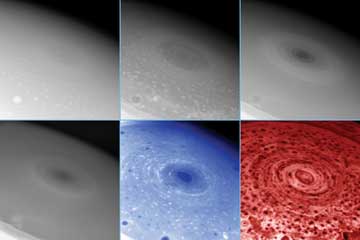|
News Notes
Space
Saturn surprises with southern storm
 Earth, Jupiter and Venus have all been observed to support giant, rotating storm masses. Now, astronomers have found that Saturn, too, boasts a hurricane-like structure at its south pole.
Earth, Jupiter and Venus have all been observed to support giant, rotating storm masses. Now, astronomers have found that Saturn, too, boasts a hurricane-like structure at its south pole.
Two different instruments aboard NASA’s Cassini spacecraft captured this series of images of a surprising storm at Saturn’s south pole. Images are arranged in order of increasing wavelength, from which scientists could infer the height of the clouds. Spots outside the eye represent individual storms. Image is courtesy of NASA/JPL/Space Science Institute/University of Arizona.
On Oct. 11, instruments aboard NASA’s Cassini spacecraft confirmed previous Earth-based measurements that an anomalous warm spot exists at Saturn’s southern pole. That heat, astronomers found, is likely associated with the compression of the atmosphere within the eye of a giant hurricane-like storm, which was captured in October by Cassini in a series of closeup images and a three-hour video, NASA announced Nov. 9.
The storm’s eye measures about 1,500 kilometers in diameter, around which winds blow up to 550 kilometers per hour. Also surrounding the eye is a towering ring of clouds that reaches 30 to 75 kilometers above clouds in the storm’s center — that’s two to five times higher than similar structures seen in storms on Earth. “That makes it different from anything else we’ve seen the solar system,” says Andrew Ingersoll, an atmospheric scientist at Caltech and member of the Cassini imaging team.
The analogy between vortices on Saturn and other planets, however, “cannot be pushed too far,” says Fred Taylor, a planetary physicist at the University of Oxford in the United Kingdom, and not associated with the find. The main difference from the vortex imaged at Venus’s south pole (see Geotimes, July 2006) is that Venus’ structure has two eyes, he says. And unlike “short-lived, traveling” hurricanes on Earth, he says, Saturn’s storm is larger, permanent and fixed at the planet’s pole.
Exactly how and when the storm came to exist at the pole is still uncertain, particularly as there is no ocean from which the storm can draw moisture. “This one is a puzzle,” Ingersoll says, but researchers will continue looking at different analogues across the solar system to help us understand the diversity of weather phenomena.
Kathryn Hansen
Links:
"Vortex visible on Venus," Geotimes, July 2006

 Subscribe
Subscribe

